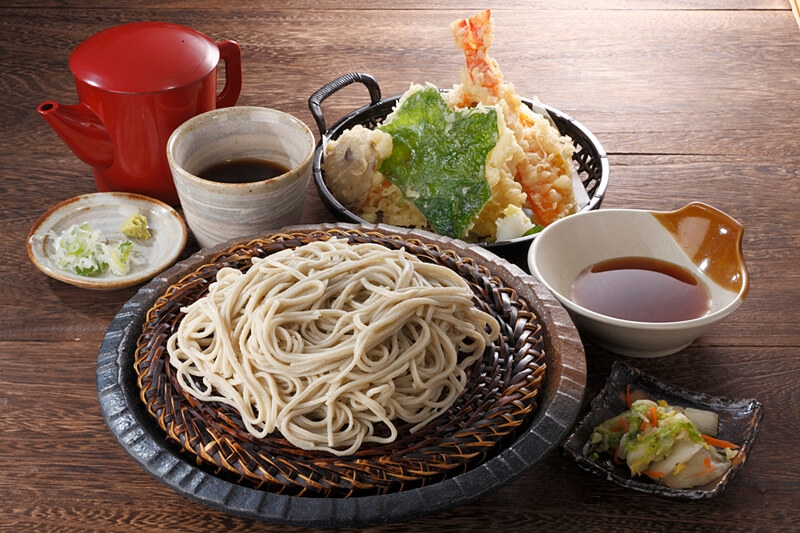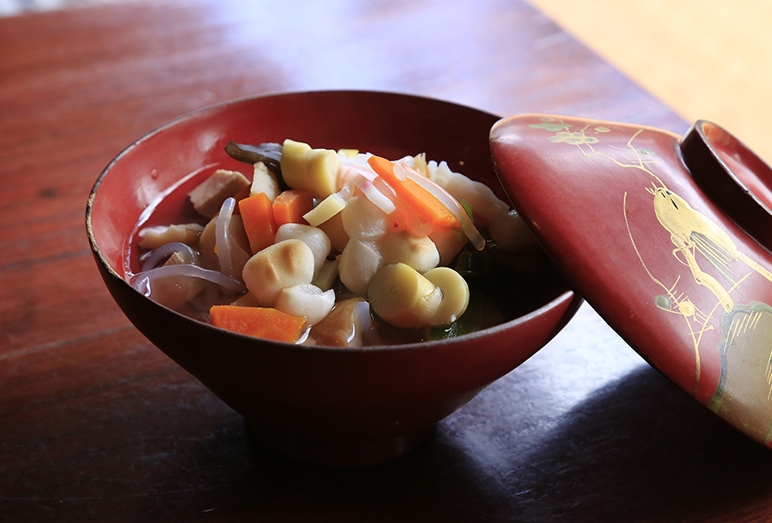Local Foods of Fukushima
Fukushima is home to unique variety of local foods and flavors, making the most of seasonal ingredients. From traditional specialties to modern takes on classic dishes to adopted foreign-inspired foods, Fukushima has something to satisfy the most hardened gourmand.
Traditional Dishes
 |
Negi-SobaNegi-soba, also known as 'Takato soba,' is a popular dish in Fukushima Prefecture's Aizu region. Long ago, when Prince Masayuki Hoshina returned to Aizu from Nagano Prefecture, a retainer from Nagano's Takato clan came with him. When people saw the retainer eating his soba-topped with grated daikon radish - with a green onion, knowledge of the practice spread throughout the Aizu area, becoming known as 'Takato-soba.' Some time later, the owner of the Misawaya restaurant in Ouchi-juku came up with the idea of serving Takato-soba with a green onion (negi) in place of chopsticks and using it as a condiment. These days, it is a popular local comfort food. Buckwheat used to make soba noodles is harvested in October and November, making autumn the best season for enjoying the freshest flavors. You should give this dish a try at least once while traveling through Fukushima. |
 |
Sauce KatsudonWhite rice topped with finely-sliced cabbage and thickly-chopped tonkatsu covered in a rich sauce which is close in flavor to Worcestershire Sauce. Tonkatsu is a pork cutlet that has been coated in breadcrumbs and fried. This dish is usually served in a large rice bowl! Make sure you try this local gourmet when you visit Aizu-Wakamatsu City. |
 |
Wappa-Meshi'Mage-Wappa' refers to a kind of container which was used as a lunch box by the woodcutters of Hinoemata Village for over 600 years. 'Wappa-Meshi' is the name given to a variety of dishes made with seasonal vegetables local to the mountains of Aizu. These unique dishes are arranged in traditional Mage-Wappa wooden containers. Seasoned Wappa-Meshi rice is made by cooking rice three-quarters of the way, adding seasoning ingredients, and then steaming the rice once more. Since it is made with seasonal ingredients, Wappa-Meshi can be enjoyed throughout the year. |
 |
Kitakata RamenThe specialty of Kitakata City, this ramen ranks amongst Japan's most famous types of ramen noodles, along with those from Sapporo and Hakata. Served in a refreshing soy sauce soup, this is a simple dish consisting of thick, crimped noodles with sliced pork, simmered bamboo shoots, and spring onions. Kitakata City has around 120 ramen establishments, making it a popular destination for ramen lovers from around Japan. |
 |
Shirakawa RamenLooking west from the Nasu mountain range, you see Shirakawa City, blessed with delicious water. Using this fantastic underground water source filtered by the rich soil the noodles and soup have become very popular; so popular in fact, that currently, Shirakawa ramen rivals that from Kitakata. The thick, crinkly noodles are normally hand-rolled with a wooden rolling pin, and the clear soy-sauce soup has a simple thickness. The roasted pork filet is prepared in a special way by baking it in a pan to lock in the taste. To ensure that no compromises are made with taste, many ramen restaurants close when they have no more noodles left. |
 |
Soba from the Aizu RegionSoba (Japanese buckwheat noodles) has its own unique cultural history in Fukushima Prefecture's Aizu region. Buckwheat, which has been cultivated in Aizu for generations, is harvested after it ripens, leading to the delicate balance of flavor and fragrance. Recently, cultivation has begun in earnest of a new kind of buckwheat called 'Aizu no Kaori' ('The flavor of Aizu'), which is chewy, sweet, and possesses a beautiful aroma. It has been recognized as a variety of soba unique to Fukushima Prefecture. We recommend trying and comparing the traditional and the new flavors. Fresh buckwheat season lasts from the end of October to December. However, you can enjoy delicious Japanese buckwheat noodles throughout the year. |
 |
KozuyuThis traditional soup is an essential dish served on auspicious occasions such as New Year and during ceremonial gatherings. Most families in central Aizu use kozuyu recipes that have been handed down for generations, and the dish can also be found at local restaurants. The soup is made with dried scallop, carrots, mushrooms, konjac noodles, mame-fu (wheat gluten croutons), and is seasoned with salt and soy sauce. Kozuyu is traditionally served in special, locally-produced lacquerware bowls. |
 |
Nishin-no-SanshozukeNishin-no-Sanshozuke is one of the representative dishes of Aizu. Herring is gutted, cleaned, and dried before being pickled with the leaves of sansho pepper and soy sauce. This particular dish can only be found in Aizu. Sansho pepper is used due to its preserving properties, unique aroma, and sour taste, which balances out the bitterness and scent of the herring. This preserving technique gives the fish an amazing taste. This dish is especially delicious as a side dish alongside a drink. Pickled herring is commonly served in special serving bowls produced by local ceramics craftsmen. |
 |
Enban GyozaThick dumpling wrappers are stuffed with vegetables and other mixed ingredients, arranged in the form of a disk, and fried in a pan. The finished dumplings are served in this disk shape exactly as they were cooked. This style is used by many gyoza restaurants in Fukushima City. Some of the city's gyoza restaurants have 40 to 50 years of history. Each location uses different ingredients, and this variation creates subtle changes in appearance and flavor. You’ll want to visit a number of the 17 restaurants serving enban gyoza to compare flavors. |
 |
Kawamata ShamoShamo are a type of chicken bred that have long been bred for eating, but with a fiery temperament and chivalrous bearing, they were also bred to be suited for cockfighting and for use as ornamental birds. In Kawamata Town, these shamo have been bred for improved flavor, giving rise to the name 'Kawamata Shamo'. Their meat has a pleasing texture and a rich flavor. The meat is not as fatty as that of standard chicken meat, and being low in calorie and high in protein, Kawamata Shamo is a very healthy meat. |
Unique Dishes of Fukushima
 |
Shirakawa Daruma BurgerUsing carefully-chosen ingredients, the Shirakawa Daruma Burger is a fast food meal which incorporates the slow food concept. The heart-shaped burger buns are made of 100% rice flour. The buns are imprinted with theh words "I LOVE 白河 (Shirakawa)", and the design is based on the Shirakawa Daruma, a traditional craft of the city. The burger ingredients are all carefully-selected and are all linked with bringing good luck. Pork Daruma Burgers are made with 'Shirakawa Kogen Seiryu Ton' pork, which is raised in the Shirakawa Highlands and provided with clear, local stream water. |
 |
Kitakata Ramen BurgerA ramen-flavored burger unique to Kitakata. The buns are made from Kitakata's 'Yukichikara' flour and filled with ingredients used for making ramen. The chashu (Chinese-style barbecued pork) filling is made from 'Hayama Kogen Ton' brand pork, raised in Fukushima's Hayama Highlands. Burgers made with local Aizu chicken are also ready to go. |
 |
Iwaki Jumbo-Sized FoodsReady for a culinary challenge you won’t forget? Iwaki City is known for jumbo-sized foods. The jumbo-sized dishes range from sweet treats to full meals, western dishes to traditional Japanese gourmet. So get ready for jumbo choux crème pastries and jumbo meat cutlets. Take this challenge alone or with friends! Just make sure you make to reserve in advance at each shop. |